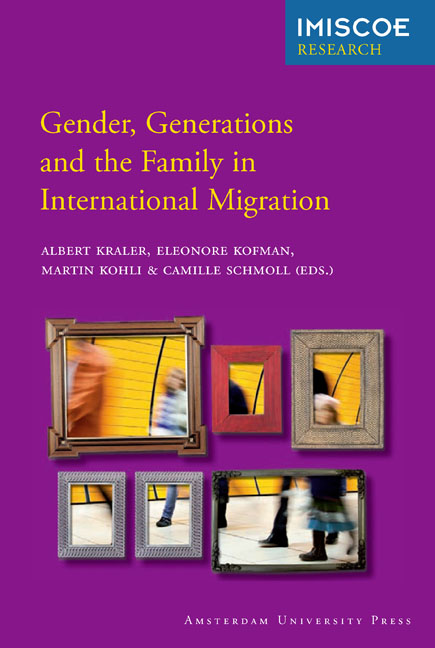Book contents
- Frontmatter
- Contents
- Preface
- 1 Introduction: Issues and Debates on Family-Related Migration and the Migrant Family: A European Perspective
- Section I The Family as a Moral and Social Order
- Section II Gender, Generation and Work in the Migrant Family
- Section III Marriage Migration and Gender Relations
- Section IV Transnational Family Lives and Practices
- List of Contributors
- Index
- Other IMISCOE titles
12 - Transnational Family Life and Female Migration in Italy: One or Multiple Patterns?
Published online by Cambridge University Press: 21 January 2021
- Frontmatter
- Contents
- Preface
- 1 Introduction: Issues and Debates on Family-Related Migration and the Migrant Family: A European Perspective
- Section I The Family as a Moral and Social Order
- Section II Gender, Generation and Work in the Migrant Family
- Section III Marriage Migration and Gender Relations
- Section IV Transnational Family Lives and Practices
- List of Contributors
- Index
- Other IMISCOE titles
Summary
Introduction
Research on transnational family life – that is, the manifold ongoing interactions between migrants, especially women, and the family members left behind – has resulted in a growing body of empirical studies over the last decade. Seldom, however, have they been conducted in a comparative perspective and much less so with respect to European Union receiving countries. The chapter draws on original empirical data to provide a novel comparison between transnational family attitudes, practices and perspectives in three migration flows, linking Italy to such diverse areas as Poland, Ukraine and Ecuador.
The three sending countries basically share some relevant traits in terms of time of immigration, gender balance and niches of employment in the receiving labour market. Each of them has produced, over the last decade or so, mostly female migrant flows to Western Europe – involving temporary or longer-term emigration to Russia, Poland, Germany and Mediterranean countries – from Ukraine; to Germany, Belgium and later France and Italy from Poland; to Spain and Italy from Ecuador.
The original data upon which the chapter builds come from different research sites. In relation to Ukrainian and Polish immigration, we rely on a national non-representative sample of interviews from 2003 to 2005 conducted with immigrant women working in the domestic sector in Italy. Most were Eastern European women, silently ‘colonising’ the domestic labour market in the country. This source has been complemented with a period of ethnography and in-depth interviews of Ukrainian women working in Italy, conducted by Ludovica Banfi, and participant observation following some interviewees in their summer journeys back home (Chernovtsi Oblast). As for Ecuadorian immigration, the chapter relies first of all on an in-depth study conducted through ethnography and biographical interviewing in a local area in Northern Italy (in the Trento province) and, to a lesser extent, in a local sending community in Ecuador (Pasaje in the El Oro province). This original source has been supplemented with preliminary field research on Ecuadorians’ transnational attitudes and social practices, which built on the unique opportunity provided by immigrants’ involvement, from a distance, in 2006 national elections.
After an overview of the literature on the familial dimension of transnational immigrant processes, we will analyse the main commonalities and differences among the three cases in relation to their socio-demographic profile, their driving forces, the role of factors such as networks, migration and immigrant policies, and the relevance of distance to the homeland.
- Type
- Chapter
- Information
- Gender, Generations and the Family in International Migration , pp. 287 - 312Publisher: Amsterdam University PressPrint publication year: 2012
- 1
- Cited by



